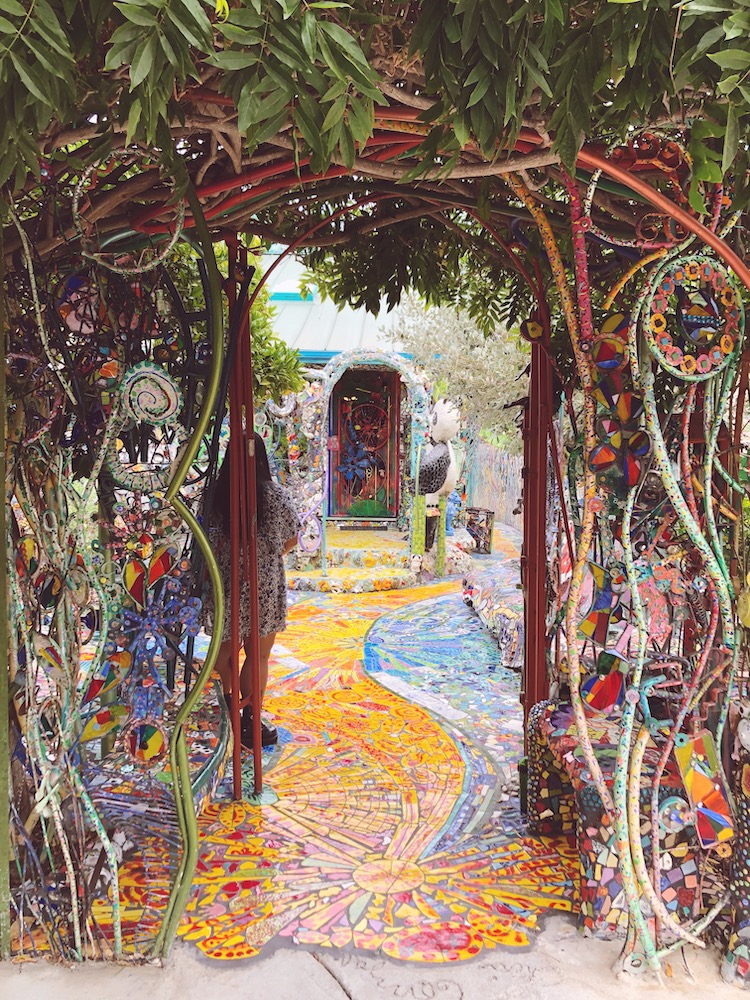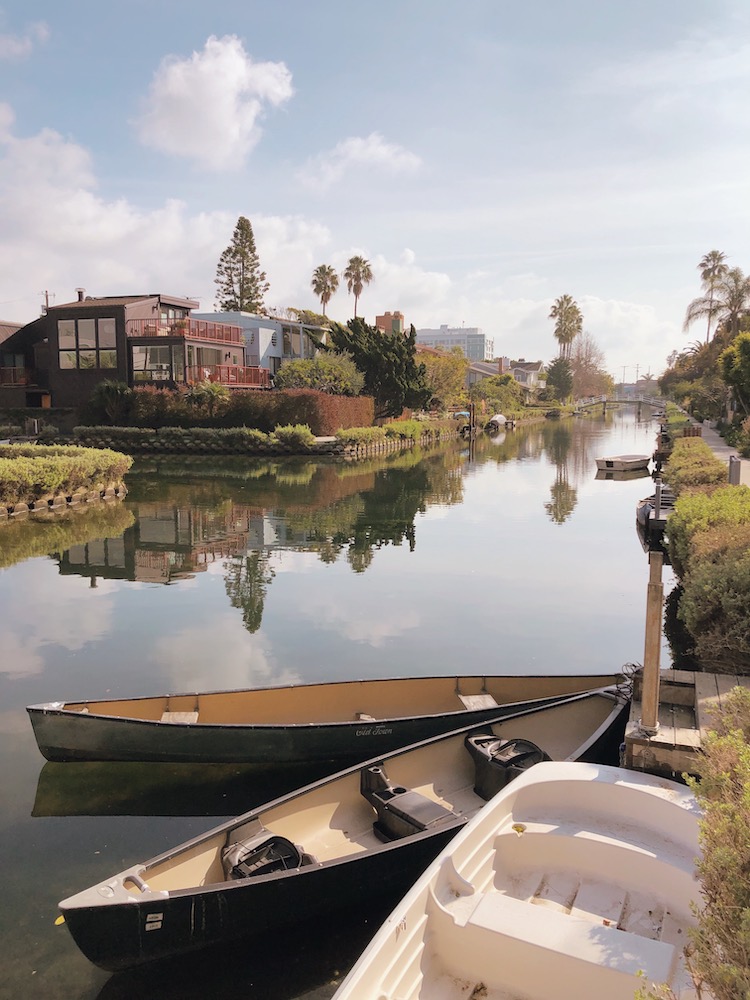 Next up in my Seven Secret Highlights travel series, we’re on the lookout for alternative things to discover in Venice Beach, California.
Next up in my Seven Secret Highlights travel series, we’re on the lookout for alternative things to discover in Venice Beach, California.
After my recent assignment to get to know Brighton’s new Twin City, Santa Monica (as it turns out, the two seaside cities are more similar than I thought), I spent two nights exploring its next-door neighbour, the world-famous bohemian Los Angeles beach enclave.
Hidden highlights of Venice Beach, LA
If you’re planning a trip to Venice Beach, most articles or blog posts direct you to the world-famous muscle beach, the boardwalk, the skate park and sometimes, shopping on Abbott Kinney Boulevard. These Venice Beach icons are must-sees, of course.
But there’s another side to Santa Monica‘s edgy neighbour that you won’t find on most tourist itineraries which gets to the off-beat heart of the destination. Let’s explore some alternative things to do in Venice Beach, California.
1 Venice ‘walk streets’
 Had I not been researching restaurants in Venice on Google Maps, I wouldn’t have known these urban gems existed. The Venice Walk Streets are a set of pedestrian-only streets inland from the beach. They date back to the 1900s and were originally part of the vision of tobacco tycoon, Abbot Kinney, who wanted to recreate Venice, Italy, in southern California, complete with a system of charming canals which you can visit today.
Had I not been researching restaurants in Venice on Google Maps, I wouldn’t have known these urban gems existed. The Venice Walk Streets are a set of pedestrian-only streets inland from the beach. They date back to the 1900s and were originally part of the vision of tobacco tycoon, Abbot Kinney, who wanted to recreate Venice, Italy, in southern California, complete with a system of charming canals which you can visit today.
 When the walk streets were first developed, it was mostly entertainers and people who worked at the Venice Pier who lived in houses along them; regular people on regular to low salaries. Today, the houses are some of the most expensive in Los Angeles, where the likes of Oscar-winning actress Julia Roberts live. Despite the influx of affluent residents, the walk streets have managed to maintain their magical appeal. Elaborate gardens, gateways and kitschy artefacts adorn each property enticing passers-by to sneak a peek.
When the walk streets were first developed, it was mostly entertainers and people who worked at the Venice Pier who lived in houses along them; regular people on regular to low salaries. Today, the houses are some of the most expensive in Los Angeles, where the likes of Oscar-winning actress Julia Roberts live. Despite the influx of affluent residents, the walk streets have managed to maintain their magical appeal. Elaborate gardens, gateways and kitschy artefacts adorn each property enticing passers-by to sneak a peek.

Discovering one of the Venice Walk Streets feels like falling down a rabbit hole and stepping out into another era. The nicest ones are Nowita Place, Marco Place, Amoroso Place and Crescent Place. I recommend beginning at Lincoln Boulevard and following Nowita to Shell Avenue. Read all about the Venice Walk Streets, here.
2 Mosaic Tile House

I left the Saturday shopping and lunch crowds on Abbott Kinney Boulevard behind a while ago. As I strolled through the tree-lined residential streets of Venice, with their mishmash of single-story homes bathed in lunchtime LA light, I wondered how much further it was. Until I spotted a cluster of people up ahead and knew I must be close.

The Mosaic Tile House had drawn a small crowd, but its location away from the centre of town felt like discovering a city secret. I couldn’t believe my eyes – a regular single-storey 1940s house, completely covered from path to front gate, roof to floor, with colourful collections of mosaic tiles. Inside it’s the same – every square inch is covered in mosaics! Even if you don’t love this art style, it’s hard not to appreciate the work that’s gone into creating it.

When husband and wife artists Cheri Pann and Gonzalo Duran first moved into their Venice home, it looked like an ordinary residential house. But over a decade, they’ve transformed their live-work space into this spectacular collage of colourful tiles, stone and clay wares open every Saturday from 12pm to 3pm. Find The Mosaic Tile House at 1116 Palms Boulevard, Venice. Booking essential
3 Venice Canals

Ever wondered why Venice Beach is called Venice Beach? It’s all thanks to a visionary tobacco tycoon called Abbot Kinney, with an idea to recreate a city after its Italian namesake in 1905. The Venice Canals Historic District, as it’s officially known, was part of this project. Today, it’s an exclusive neighbourhood consisting of three blocks set around six man-made canals: Grand and Eastern canals run north-south; Carroll, Linnie, Howland and Sherman stretch east-west.

So serene is the community, it’s hard to believe you’re just a minute’s walk east of Venice’s crowded boardwalks and traffic, and mile-long Abbot Kinney Boulevard with its shops, restaurants, and galleries. It’s an easy place to explore on foot, wandering and weaving your way around along the quiet sun-dappled waterside pathways, over the arched wooden pedestrian bridges.

To get there: we parked at the end of Venice Boulevard, walked south on the boardwalk to 25th Avenue, and then cut into the canals. At 25th Avenue, you can see a sign for the canals, as well as a walkway that leads you directly into the area. You can also explore the neighbourhood by boat if it doesn’t have a motor and you enter via the launch ramp at Venice Boulevard (see here). Read more about the Venice Canals, here.
4 Gjusta Bakery
 Gjusta is not a city secret by any means and gets packed every day, especially at weekend brunch time. That said, it’s made it onto my hit list as a fun food destination to discover away from the Venice Beach drag. It also might just be the most beautiful bakery I’ve ever seen. It’s set in a whitewashed warehouse-style building with wooden shutters. To the side, is a big sunlit cobbled courtyard garden hung with string lights and filled seats in the shade of a huge old olive tree.
Gjusta is not a city secret by any means and gets packed every day, especially at weekend brunch time. That said, it’s made it onto my hit list as a fun food destination to discover away from the Venice Beach drag. It also might just be the most beautiful bakery I’ve ever seen. It’s set in a whitewashed warehouse-style building with wooden shutters. To the side, is a big sunlit cobbled courtyard garden hung with string lights and filled seats in the shade of a huge old olive tree.
 To order food, head inside where you grab a numbered ticket and wait your turn. It can seem a bit chaotic if it’s busy – the line snaked out the door when I was there – but once you’ve eyed the tempting stacks of pastries, platters of salad, generous sandwiches, and pretty platefuls, there’s no turning back. While you wait in line, have a snoop at this hidden holiday apartment for two to rent above the bakery!
To order food, head inside where you grab a numbered ticket and wait your turn. It can seem a bit chaotic if it’s busy – the line snaked out the door when I was there – but once you’ve eyed the tempting stacks of pastries, platters of salad, generous sandwiches, and pretty platefuls, there’s no turning back. While you wait in line, have a snoop at this hidden holiday apartment for two to rent above the bakery!

Find Gjusta at 320 Sunset Avenue, Venice
5 Cocktails in an original 1920 speakeasy

The Del Monte underground live music venue in the basement of a bar is the oldest bar in Venice with a fascinating history. Cesar Menotti opened his bar in 1915. Though this drinking establishment is now called Townhouse, with the Del Monte Speakeasy in the basement, its early name, Menotti’s Buffet, can still be seen in tile near the front door.

It was a popular local gathering place since its opening, but when Prohibition began in 1920, Menotti got creative. The bar moved underground while he turned the upper level of his business into a grocery shop, laying out displays of fruits and veggies. Genius! Alcohol was brought in by boats from Canada and then smuggled via underground tunnels.

Imagine getting into Menotti’s Buffet during Prohibition. First, you had to know the speakeasy existed underneath a Venice grocery shop. Plus, you also had to know the bartender. And be willing to enter the bar via a tiny two-person, rope-operated dumbwaiter through a trapdoor. Needless to say, once Prohibition ended in 1933, a staircase was added. Find the Del Monte inside Townhouse at 52 Windward Avenue, Venice
6 El Bordello Alexandria Apartments

This is the most unique sight I stumbled upon while in Venice. One block from the Venice Beach boardwalk is a 1906 building decorated with bizarre murals and statues. It belongs to an artist couple, Tony Wells and Brittany Stevenson. They bought it and named it El Bordello Alexandra: a nod to the building’s history, and Stevenson’s late friend. According to the LA Times, ‘It’s more than a building. It’s a vibe.’

There are nine apartments inside the building, the couple rent to artists, musicians, and other like-minded folks who don’t mind their home being gawked at by people like me. The owners continually add to the decorations outside the building, with art and murals by Brian Mylius, who lives in the building.
7 The Peep Hole Box

This public art installation on the junction of Abbot Kinney Boulevard and Windward Avenue is by a local artist called, Robin Murez. Peek through the tiny hole in the box and you’ll see old-fashioned pictures of the street it’s located on and a nearby area called Windward Circle in the early 1900s when the area was home to a canal and a lagoon with an 80-feet high diving platform, giant swing, and even a rollercoaster, all since long gone, obviously!

Bonus HIDDEN HIGHLIGHT of Venice Beach – the storied Venice V Hotel
My favourite kinds of hotels are those set in reimagined historic buildings, like the Venice V in a 1915 landmark – originally The Waldorf – slap-bang on the Venice Beach boardwalk for sea views and watching the Venice Electric Light Parade. When it originally opened, it was dubbed “the Crown Jewel of Venice” for its modern amenities like steam, heat, electricity and a telephone in each room.

Over the last century, the V has served as the backdrop for countless Hollywood films and has been home to early A-List stars, many of whom lived long-term in the penthouse bungalows – where I stayed! During Venice Beach’s Golden Era, it hosted Charlie Chaplin and Clara Bow. Later on, in the Sixties, it became a hangout for the Doors, and in the Seventies, it was home to skaters of the legendary Z-Boy crew.

Today it’s been completely refurbished, and many period details preserved, like the exposed interior steel beams, central staircase, and the lift with etched bronze doors, mahogany, and brass interior, alongside modern artwork, like the striking lobby mural of Venice visionary Abbot Kinney made of skateboard wheels.
Find the Venice V Hotel at 5 Westminster Avenue, Venice
Enjoy reading this post? Fancy buying me a coffee?
New here? Head over to check in for a welcome tour, join other curious travellers and subscribe to Ellie & Co via email or follow my stories on Instagram, Twitter or Facebook.




